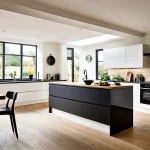Essential design principles for efficient UK kitchens
Efficient kitchen design in the UK hinges on maximizing space planning, especially given the varied property types across the country. UK kitchen design often grapples with smaller footprints requiring smart, functional kitchen layouts that optimize every inch. An effective layout reduces unnecessary movement and enhances workflow, allowing users to prepare meals swiftly and comfortably.
Current trends highlight the importance of integrating multi-functional zones within the kitchen, making room for cooking, dining, and storage without compromising openness. Designers emphasize ergonomic placements of appliances and worktops to support ease of use. For instance, positioning the sink, stove, and fridge in close proximity forms the vital “kitchen work triangle,” a proven principle to elevate kitchen efficiency.
Topic to read : Transform uk kitchens: maximizing culinary spaces with sleek designs
British homes vary greatly—from compact urban flats to spacious countryside houses—so UK kitchen design must be adaptable. In smaller spaces, vertical storage solutions and built-in appliances help maintain visual neatness and practicality. Conversely, larger UK kitchens benefit from island units that enhance workspace while promoting social interaction. Regardless of size, the goal of good space planning remains the same: to create an environment that supports a seamless cooking experience.
Smart storage solutions for small and awkward spaces
When dealing with small or awkward kitchens, kitchen storage solutions that maximize every inch become essential. Innovative cabinetry and pull-out systems offer a game-changing approach. These systems allow for items to be tucked away neatly yet remain easily accessible, drastically reducing clutter. For example, pull-out pantries and sliding shelves can store spices, utensils, or cleaning supplies while occupying minimal space.
Additional reading : The best compact kitchen appliances for small uk spaces: top picks
Vertical and corner storage maximisation plays a crucial role in compact kitchen ideas. Utilizing wall-mounted shelves or tall cabinets exploits vertical space efficiently, freeing up valuable countertop and floor areas. Corner cabinets equipped with rotating carousels or pull-out trays convert often-underused corners into functional storage spots. This method is especially effective in awkward layouts where standard rectangular cabinetry is less practical.
Multipurpose furniture contributes further to space-saving designs. Counter stools with built-in storage or foldable dining tables serve dual functions, promoting flexibility without sacrificing style. These solutions adapt to changing needs, making the kitchen more versatile while maintaining a streamlined appearance.
By focusing on these space-saving designs, you can transform even the most limited or oddly shaped kitchen into an organized and efficient workspace.
Integrating technology and smart appliances
Explore how smart devices elevate kitchen functionality and sustainability.
Smart kitchen appliances are revolutionizing the heart of UK homes by boosting both efficiency and convenience. These modern gadgets allow users to control ovens, refrigerators, and even coffee machines remotely through apps, enabling better time management during meal preparation. With features like automatic cooking adjustments and inventory tracking, they minimize waste and optimize kitchen workflows.
Energy saving kitchens focus on incorporating eco-friendly technology that reduces electricity consumption without sacrificing performance. For example, induction cooktops heat faster and use less energy compared to traditional stoves, while smart refrigerators adjust cooling based on usage patterns to conserve power. These innovations support environmental goals while cutting household energy bills.
Seamless integration is crucial when incorporating smart kitchen appliances into various design schemes. Devices now come with sleek aesthetics and can connect wirelessly, allowing for a clutter-free environment. Whether it is built-in smart ovens or silent, automated dishwashers, these technologies blend functionality with contemporary UK kitchen technology trends, enhancing both usability and style.
Creative optimisation for UK-specific challenges
Narrow, galley, and L-shaped kitchens are common in many UK homes, presenting unique obstacles when it comes to functionality and space utilisation. These British kitchen challenges demand thoughtful planning and innovative design to maximise every inch without compromising style or practicality.
One effective approach to managing awkward kitchen spaces is through bespoke solutions tailored specifically for the layout. Custom cabinetry, slimline appliances, and clever storage options allow homeowners to transform these compact or oddly shaped rooms into highly efficient cooking areas. For example, in many L-shaped kitchens, corner units with swivel shelves can maximise access to hard-to-reach areas, turning wasted space into valuable storage.
Custom design options also extend to worktop arrangements and lighting placement, adapting to structural quirks often found in historic or period properties. By considering individual kitchen dimensions and features, bespoke solutions help clients personalise their space while overcoming constraints such as low ceilings or angled walls.
Successful UK kitchen transformations often showcase how tailored designs address the inherent challenges of these layouts. Whether it’s integrating multi-functional islands into narrow rooms or using vertical storage to open up floor space, creative optimisation makes the best use of limited areas while elevating the overall aesthetic. Such approaches highlight the powerful role customisation plays in turning British kitchen challenges into stunning, practical kitchens.
Expert insights and real-life inspiration
Unlock practical wisdom for your kitchen project
Expert advice on maximising efficiency
When considering a kitchen remodel, kitchen designer tips are invaluable for optimising space and functionality. Experts recommend starting with a clear plan to enhance workflow and storage. For example, focusing on the classic “work triangle” between the sink, stove, and refrigerator ensures efficient movement. Kitchen designers stress the importance of custom storage solutions, such as pull-out drawers and corner units, to maximise usable space even in compact kitchens. Lighting should not be overlooked; layered lighting—ambient, task, and accent—improves both functionality and ambiance.
Visual before-and-after transformations
Before and after kitchens offer inspiring evidence of what thoughtful design can achieve. A typical transformation might involve replacing bulky, outdated cabinets with sleek, handle-free units that open up the room visually. Adding new surfaces like quartz or natural stone can refresh the overall look while improving durability. Planning to see before and after kitchens not only shows aesthetic upgrades but also highlights improvements in efficiency, like added pantry space or integrated appliances. These examples often demonstrate how modest structural changes can create a significant impact.
Inspiring UK kitchen makeovers and case studies
UK kitchen remodel examples abound with creative solutions tailored to diverse homes and budgets. Many incorporate blending modern styles with traditional elements to reflect regional tastes. Case studies reveal how bespoke cabinetry and smart technology installation, such as touch-activated faucets or app-controlled lighting, can enhance daily life. Inspiration from these real-life projects underlines the importance of working with professionals who understand local building regulations and sourcing high-quality materials. Emulating successful UK kitchen remodel examples ensures both beauty and practical longevity in your kitchen upgrade.

